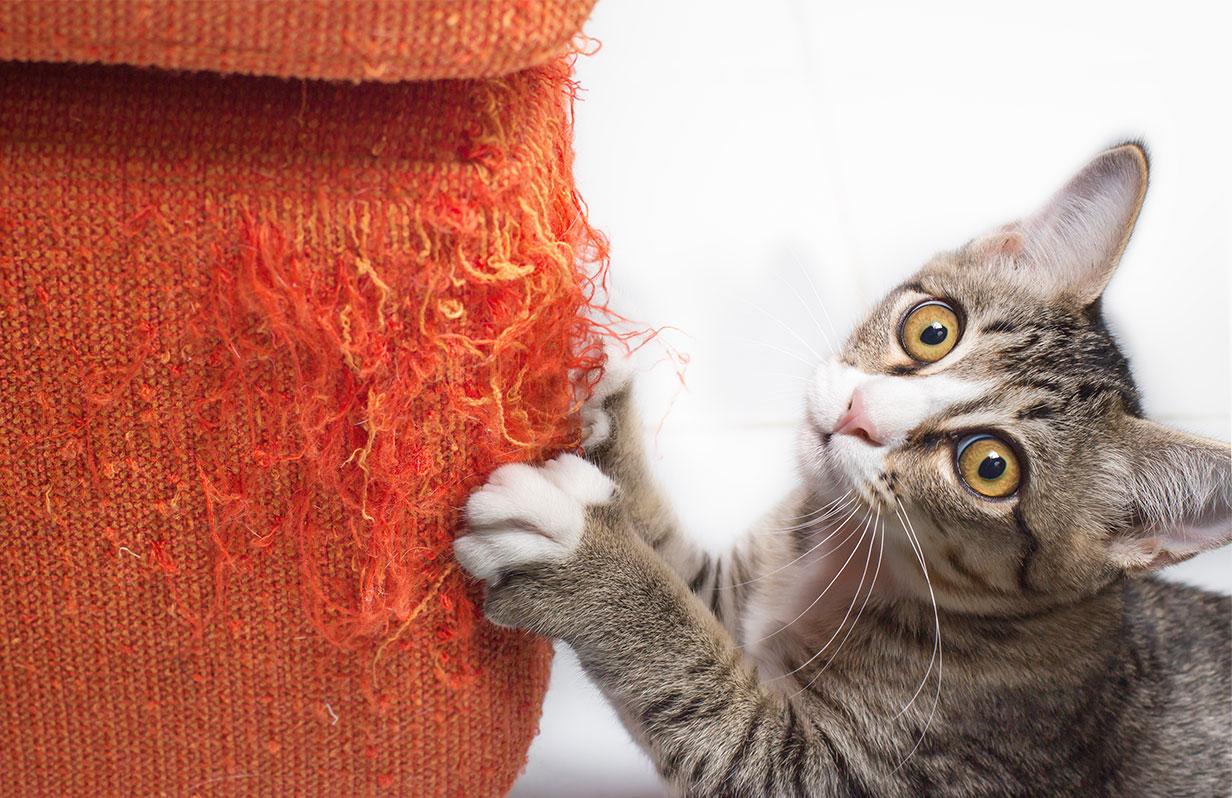
Why do cats scratch?
Why Do Cats Scratch?
Have to explain to your already annoyed husband that the cat has just scratched the side of your beautiful new – rather expensive – sofa? Cringe! Is patience running thin for your - oh so beautiful - cat that you promised would not cause a moment’s trouble?
Well, you are not alone. In this country where most – if not all – domestic cats are kept nearly 100% of the time indoors, reports of cats scratching beloved and sometimes treasured furniture pieces is common. Not enough to destroy it, but just enough to break your heart.
Why you ask?
Unfortunately, this is completely natural. “Cats in the wild scratch logs. They do this to mark their territory, just like domestic cats mark their territory,” says Jennifer Conrad, DVM and founder and director of the Paw Project, the world’s largest nonprofit dedicated solely to ending the practice of declawing. Indoor cats will just try and find a substitute. They are not being bad or naughty, it is just natural. They don’t know the difference – or really care to know – the difference between your lovely silk handmade persian carpet, your sofa or the log outside.
According to Dr. Conrad, “Cats scratch for a variety of reasons. It relieves anxiety; it’s a form of exercise; it hones their nails; it strengthens and stretches their muscles; it marks territory.” Apparently, scratching is a very important to your cat’s life. In your home, “Cats scratch furniture because they are marking territory in places where you sit,” explains Dr. Conrad. There are scent glands in the pads of their paws, that release a cat’s unique scent onto everything they scratch. In the wild this a visual and olfactory way to mark territory.
And yes, there is help! Thank God!
To encourage good scratching behaviours keep several scratching posts and scratchers around the house. Dr. Conrad points out that “You have to let your cat select what material your cat wants to scratch… Cats have preferences.” The key is to try and replace the furniture for a scratching board of similar material. For example, try placing a scratching post made of wood near your wooden table that your kitty has taken a liking to. A sprinkle of catnip on the scratchers does wonders for luring cats in. Some also recommend using the ever dreaded double-sided sticky tape that cats hate to feel on their paws – pay back time! – Well, maybe only until the cat learns that it’s more fun to claw the new scratching posts.
Cats also love corrugated cardboard, like Scratching Post, with Catnip or 2-in-1 Cat Scratcher & Cave. But some might prefer other textures, like carpet, sisal rope or wood.
Scratching Post is covered in durable woven sisal and allows for a full-body stretch. With the Fauna Sagrada Cat Scratching Pole cats get sisal plus a feathered toy for more options.
The full range can be found on this link.
A good old fashioned nail trim can help
Cats tend to scratch as a way of naturally filing down their nails. Having regular trims may help the urge to do this as often, plus might not cause as much damage. Dr. Conrad suggests making it a fun experience by offering treats for allowing you to touch your cat’s paws. “Do this over and over again until the cat realizes that if he or she lets you touch the paws, and trim the nails, there’s a treat involved. You have to find a treat that motivates your cat.”
Declawing your cat should NEVER be considered as a solution. It is extremely cruel and painful and leads to many unwanted cat behaviors as a result, such as trouble using the litter box and resorting to biting as a primary defense. Unbeknown to many, declawing involves the amputation of the last bone in it in the cat’s paws, which really means ‘deknuckling’ them. Cats that have been declawed have life changing problems with walking and jumping as well as pain and a chance for infection.
Scratching people?
No cat owner can claim to have never been scratched by their cat. A few of us have been on the receiving end of that painful swipe. Unfortunately, just comes with the territory. You just have to bear in mind that it may not always be malicious.
This amongst other reasons can be a defensive tactic when cats feel threatened. In this case, your kitty wants to be left alone and needs some space.
Have any of you experienced the odd moment when your cat catches your hand now and again during a biting and bunny-kicking frenzy? Well, think you are playing with them. Touching their tummies could lead to this, so be aware of the belly!
We always recommend using a toy to play rather than your hand to avoid getting hurt. More can be found on a cat wand.
“If your cat is scratching you in an aggressive manner,” adds Dr. Conrad, “you should speak with a certified cat behaviorist. These behaviors can be trained out of a cat.”
All in all, please note that cat scratching is completely normal. The good thing is that with the help of a few scratching posts and maybe a sprinkle of some catnip, your cat can be trained onto scratching on the right surfaces and places, forsaking your beloved furniture, carpets and maybe even your marriage! Remember to be patient and try a few different scratching materials to find out what your cat prefers and likes best. It takes time and patience to be a pet owner. Here’s to healthy (and appropriate) scratching!
Fun Cat Fact: Most cats only have 18 toes total—10 in front and 8 in back.
- 466
